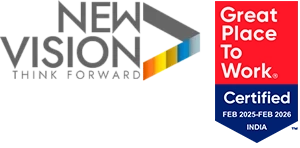
Cloud migration is happening at a rapid pace, with nearly 45% of organizations having moved half of their applications to the Cloud. Among other benefits, respondents have cited improved reliability and recovery capabilities as the top reasons, followed by increased data accessibility and enhanced security.
Clearly the Cloud momentum has garnered speed, as more organizations reap the benefits and prove that it is worth embarking on the journey. Despite the success stories, there are many challenges, with some studies suggesting that one in three Cloud migrations have failed to meet the intended objectives, and more than 50% of migration projects are more challenging than expected.
NewVision has enabled the Cloud journey of many large and small organizations across verticals and have acquired deep insights into the pitfalls and what works during the migration process.
Cloud Migration Challenges
Migrating workloads to the Cloud is fraught with challenges, and organizations that understand these challenges are better equipped to deal with the migration. Despite the obvious, often the absence of a comprehensive Cloud migration strategy leads to sub-optimal outcomes. A comprehensive strategy should include defining the objectives, selecting the right public Cloud provider and the identifying the right workloads to move to the Cloud.
Organizations often falter in making an accurate estimate of Cloud migration. Given that there are multiple pricing strategies and different types of services, organizations make mistakes in making the right choices and experience escalating costs. There are also hidden costs in data migration, such as, the need to upgrade connectivity to accommodate higher bandwidth requirements.
Designing a Cloud architecture that aligns with the existing IT systems while meeting with the goals of migration is challenging, as it must take into account legacy systems and dependencies that were not designed for Cloud integration.
Cloud Migration Roadmap for Businesses
Below we share some practical tips and actionable insights, based on our expertise and experience, on how to better prepare the organization and thus, smoothen the journey to the Cloud.
- Take the plunge: While planning is crucial, getting started is the key. Too often, organizations get mired in execution details which bogs down the process and stalls the migration program. NewVision experts find that savvy adopters start with a small team of engineers opening an account with Microsoft Azure or on AWS Cloud, and trying out services from the console. This sets the pace within the organization as engineers become familiar with the environment to spin up instances, try out different regions and get an opportunity to understand the different tiers of services. Most public Cloud providers offer a free tier which is good to get started, and many organizations actually start production workloads from the free tier before upgrading to different instances and services.
- Executive Sponsorship for Cloud:Needless to say, strong executive sponsorship bolsters the program, providing the much-required momentum and fostering collaboration across stakeholders to galvanize the strategic move to the Cloud. Usually, the Cloud initiative is headed by the CIO or the CTO with the backing of the CEO and the CFO. Sometimes in large-scale migrations it is the business head such as the COO, and sometimes even the CEO leads from the front to facilitate the alignment of technical and business objectives; managing the short-term and long-term goals; and stakeholder expectations. Given that Cloud migration has many complexities, the executive office of the Cloud Center of Excellence comprises representatives from legal, procurement, risk management, CISO, heads of infrastructure and delivery along with Cloud evangelists.
- Set Migration Goals: Organizations must have clear goals and expectations which will help benchmark efforts and take corrective action to steer the course of migration successfully. The objectives could be business reasons such as cost savings, enhanced customer experiences, improved agility or it could be technical benefits such as improved scalability or enhanced security. At the same time, it is important to ensure that there is alignment of business and technical goals. For instance, the need for enhanced customer experience and high performance may clash with the objective of cost-efficiency, as meeting the former objective will require auto-scaling and fail-over strategies which will be more costly. Managing stakeholder expectations is a key requirement in setting migration goals.
- Reach out to Cloud Migration Experts: Set up a dedicated session with an experienced Cloud migration services provider to get clarity on many critical aspects which will affect the decision making. It is important to address all the doubts, so take a systematic approach in collecting the queries of different stakeholders and have a detailed discussion with an experienced provider. These sessions will provide clarity on the big picture, guidance in navigating licensing and pricing issues, security and compliances, architectural best practices, all of which will help you make informed decisions.
- Assessment of IT Estate: Conduct a comprehensive evaluation of your organization’s IT landscape. Start by creating a detailed inventory of all systems and applications. Document key details such as version numbers, usage patterns, interdependencies, and business criticality. Identify strategic applications by mapping their criticality to business operations and examining interdependencies, performance, and security implications. This thorough analysis will reveal which applications should be prioritized for migration. For instance, workloads experiencing variable peak loads or sudden traffic bursts are ideal candidates for the Cloud due to its inherent scalability. Additionally, applications nearing end-of-life can be modernized by moving them to the Cloud, reducing legacy maintenance burdens.
- Establish a Governance Framework: A Cloud governance framework is essential to ensure that migration goals are met. Apart from aligning security and compliance objectives, the governance framework must establish policies and guidelines for financial management, operations, data management, performance and asset management. Typically, the framework will define the outcomes in the desired areas without specifying the procedures, as technologies and approaches change rapidly. For instance, data governance policy can mandate encryption to store sensitive data without specifying which tool to use. The governance framework is also essential to sort out overlapping objectives, such as, security and data management; operations management and cost control.
- Communication Strategy: Put in place a strong communication strategy as Cloud migration will affect all stakeholders in the organization, and therefore a solid communication plan will help smoothen the process. First, identify all internal stakeholders and communicate about the need, objectives and migration roadmap. It is also important to keep external stakeholders such as migration partner and collaborators on the same page. Next, identify what needs to be communicated to each stakeholder. For example, CXOs will be interested in knowing about the legalities, possible business disruptions and ROIs while HR and operations will be keen to know more about change management, employee onboarding, business continuity in terms of access to resources, etc. At the same time, educating stakeholders about the nuances of the new model is an important communication objective. For instance, procurement must become adept with managing an operating expenditure, while legal will need to understand the implications of a borderless organization.
- Talent Management and Skill Mapping:Prepare the workforce with skillsets for migration using an integrated approach that includes skill evaluation, mapping of existing skill sets, upgrading with training, strategic hiring and leaning on an external partner for skills that are difficult to bridge. An experienced partner brings technical expertise and helps to make informed choices to meet technical and business goals.
- Establish a Cloud Center of Excellence: The Cloud Center of Excellence is a cross-functional team of experts. It is the hub of activity and will oversee practically everything from defining the Cloud strategy, selecting the right public Cloud platform, assessment of IT estate, defining the migration roadmap, managing the execution including developing a governance framework, and providing training and support.
Cloud Migration Consulting Services
As an experienced consulting and solutions provider, NewVision Software has enabled complex migrations, based on which we have developed institutional assets and knowledge repository to provide a strong operational foundation for successful migrations. This includes a migration methodology for executing legacy migrations in a methodical way with a robust set of tools to automate and accelerate common migration scenarios.
Customers have successfully migrated workloads to Microsoft Azure and are harvesting the inherent benefits of the platform, including agility, scalability and quick access to the advanced technology resources. These capabilities are empowering customers to experiment often, innovate at speed and take up competitive positions in the market. Working with an expert like NewVision to define a Cloud migration strategy has facilitated customers to prepare the organization well, and look beyond the nitty gritty of migration and focus on growth and differentiation.

